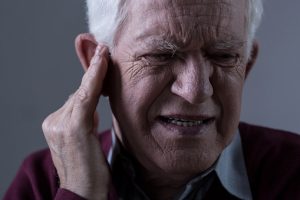
It is often difficult for doctors to find the exact cause of tinnitus; however, they commonly uncover a cause for pulsatile tinnitus.
What causes pulsatile tinnitus?
- Head and neck tumors
- Atherosclerosis
- High blood pressure
- Turbulent blood flow
- Malformation of capillaries
- Altered awareness: conductive awareness occurs when a perforated eardrum causes the individual to become more aware of blood flow. Heightened sensitivity in the auditory pathways alerts the brain to normal noise in the blood vessels.
Essentially, in pulsatile tinnitus, the main cause is a change in the blood flow in the ear. Causes for these changes in blood flow include:
- Generalized increased blood flow: blood flow moves more quickly to the ear. This can occur due to exercise, pregnancy, hyperthyroidism or severe anemia.
- Localized increased flow: a single blood vessel can increase blood flow to the ear.
- Turbulent blood flow: the inside of a blood vessel becomes irregular causing blood flow to become turbulent.
Other causes of tinnitus
As mentioned, tinnitus can be caused by cell damage in the ear, resulting from age, loud noises, earwax blockage and changes to the ear bone. Other causes of tinnitus include:
- Meniere’s disease
- TMJ disorders – lock jaw
- Head or neck injuries
- Acoustic neuroma – a benign tumor
- Certain medications (antibiotics, cancer drugs, diuretics, medications used for malaria, certain antidepressants can worsen tinnitus, aspirin)
Symptoms associated with tinnitus
Symptoms related to pulsatile tinnitus include hearing a steady sound which syncs with your heartbeat. This sound may only be heard in one ear. This sound can be distracting and for some completely unbearable and make performing daily tasks difficult.
Other symptoms may arise in pulsatile tinnitus if a patient has high pressure of fluid around the brain. This is known as idiopathic intracranial hypertension and the symptoms include:
- Headaches
- Dizziness
- Vision problems
- Hearing loss
Complications and risk factors of tinnitus
- Loud noise exposure
- Age
- Gender (men are more likely to experience tinnitus than women, often because typical male jobs expose them to louder noises)
- Smoking
- Cardiovascular problems (they can affect blood flow)
Complications associated with tinnitus are:
- Fatigue
- Stress
- Sleep problems
- Trouble concentrating
- Memory problems
- Depression
- Anxiety and irritability
Patulous Eustachian tube dysfunction and tinnitus
Patulous Eustachian tube (PET) dysfunction is a condition where the Eustachian tube does not open properly due to the swelling of the tube’s tissues or surrounding areas, such as the tonsils or adenoids. The Eustachian tube runs from the pharynx to the cavity of the middle ear, allowing pressure to be equalized in the eardrum. Patulous Eustachian tube dysfunction can lead to symptoms such as hearing one’s own voice abnormally loud, hearing generally sounds abnormally loud and sometimes distortion of speech and sounds overall.
Treatment for Patulous Eustachian tube dysfunction involves surgery to correct or modify the Eustachian tube or to partially plug the tube.
How to Diagnose Pulsatile Tinnitus
Pulsatile tinnitus diagnosis begins with your doctor taking your medical history and symptoms. They will also examine your eardrums and blood vessels in the neck. Another important diagnostic measure for pulsatile tinnitus is the use of images. There are a variety of imaging techniques including ultrasound, MRI, MRA, CT scan, CTA, and angiography.
Your doctor may also request blood tests to rule out other causes of ringing in the ears. Blood tests can rule out anemia. Your doctor may also request a thyroid function test if they suspect an overactive thyroid is the root cause.
You may have to see a series of doctors to obtain a proper diagnosis including an ophthalmologist or neurologist which may request their own set of specialized tests.
Treatment Options for Pulsatile Tinnitus
There are numerous treatments available for tinnitus to lessen the ringing and buzzing one may have to endure, unfortunately, there is no cure for tinnitus. Treatment of tinnitus can include any of the following:
- Anti-anxiety or antidepressant medications
- Using a fan or radio while sleeping as “white noise” in order to overpower nighttime tinnitus
- Managing stress, which may worsen tinnitus
- Tinnitus retraining therapy (TRT) to learn to accept sounds and become less aware of them
- Avoiding the use of aspirin
- Protecting the ears, so hearing loss does not worsen, i.e., avoiding loud noises
- If caused by a tumor, involves treating or removing the tumor, if other medical conditions are the cause of tinnitus treatment of the underlying cause often helps the tinnitus
- Cochlear implants
- Earwax removal
- Changing medications which may make tinnitus worse
- Reducing alcohol consumption
- Sound therapy which uses sound such as “white noise” as a distraction from the constant noise a patient hears
- Cognitive behaviour therapy is a form of therapy that helps you rethink about a problem and change your emotional reaction and your behaviour towards the problem
Preventing tinnitus
Additionally, keep volumes to a minimal – especially if you are wearing headphones. TV volume should also be kept in normal range. Lastly, proper cardiovascular health is another way to prevent tinnitus, including pulsatile tinnitus. Lifestyle factors, such as not smoking, eating well and exercising, can go a long way to improve heart health.
Although you can turn back time or reverse damage that has already occurred, by becoming more mindful to ear threats you can slow down any future hearing problems, and help prevent the complications which come along with hearing loss and tinnitus.